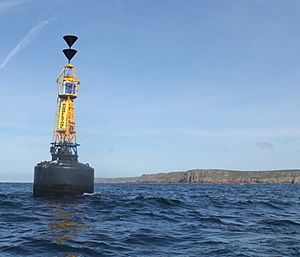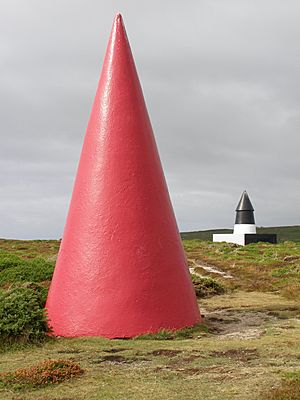Runnel Stone facts for kids
Quick facts for kids Runnel Stone |
|
|---|---|

Cardinal mark anchored to the south of the Runnel Stone to guide ships away from the reef
|
|
| Lua error in Module:Location_map at line 420: attempt to index field 'wikibase' (a nil value). | |
| Location | Cornwall, UK |
The Runnel Stone (also called Men Reunel, which means 'stone abounding in seals' in the Cornish language) is a dangerous rock in the sea. It's located about 1 mile (1.6 km) south of Gwennap Head in Cornwall, United Kingdom. This rock used to stick out of the water when the tide was low. But in 1923, a large steamship hit it, breaking off its top. Now, it stays hidden underwater.
Contents
How Ships Avoid the Runnel Stone
The Runnel Stone is a big danger for ships. Because of this, special markers are used to warn sailors and help them avoid hitting the rock.
Current Sea Markers
The Runnelstone Buoy
A special floating marker called a buoy shows where the Runnel Stone is. This buoy helps guide ships safely around the rock.
Until 2012, this buoy had a flashing light and a bell that rang with the waves. It also had a whistle that made a sad, moaning sound when the sea was rough. This sound could be heard from the cliffs, making foggy days feel a bit spooky! In 2012, a new, larger buoy was put in place. It still has a whistle to warn ships.
Land Markers on Gwennap Head

On the land, near Gwennap Head, there are two cone-shaped markers. These are called day markers because they are used during the day. They help ships know if they are getting too close to the Runnel Stone.
The cone closer to the sea is red. The one further inland is black and white. To stay safe, sailors must always keep the black and white cone in sight. If the red cone completely hides the black and white one, it means the ship is directly over the Runnel Stone! These markers were put up in 1821 by Trinity House, an organization that helps keep shipping safe.
Past Ways to Mark the Stone
Old Beacons and Poles
For a long time, people tried to mark the Runnel Stone. In 1795, a simple iron pole was put there, but the sea quickly washed it away.
Later, in 1841, a new beacon was built. This was very hard because the rock was mostly underwater. Workers could only land on it during certain tides, and even then, the sea was often too rough. This beacon was a tall iron mast with a ball on top. But strong storms kept breaking these beacons. One was destroyed in 1844, and another in 1854. After many tries, people decided that a buoy would be a better way to mark the danger.
Early Buoys
Before the current buoy, there were other attempts to use buoys. In 1824, a naval officer tried to attach buoys. Over the years, different types of buoys were used.
One special bell buoy was designed in 1856. It had a bell that was hit by four clappers as the buoy moved with the waves. Later, in 1881, another buoy was added. It had a bell and four large iron balls. As waves lifted the buoy, the balls would roll and hit the bell. People living nearby were asked to listen to the two bell buoys to see which one worked best.
Longships Lighthouse Warning
In the 1870s, when the Longships Lighthouse was rebuilt, it got a new feature. Its light was mostly white, but it had red sections. One of these red sections pointed directly at the Runnel Stone. This warned ships that they were near a dangerous area.
Shipwrecks at the Runnel Stone
The Runnel Stone has caused many shipwrecks over the years. Between 1880 and 1923, more than thirty steamships crashed or sank in this area.
During World War I, a Royal Navy minesweeper hit the rock. Even though a local fisherman on board knew the danger, he was told to stay quiet.
The most famous shipwreck happened on October 8, 1923. A large ship called the SS City of Westminster hit the rock in thick fog. This powerful crash broke off the top of the Runnel Stone! All 72 people on board were rescued by lifeboats from Sennen and Penlee. Today, parts of the ship rest in 30 meters (98 feet) of water. Since this event, the rock is less dangerous, and no ships have been wrecked there.
Diving at the Runnel Stone
The Runnel Stone is known as one of the best places for scuba diving in all of Cornwall. This is because of its clear waters and easy access from nearby slipways.
Divers must go when the water is calm, which is about one and a half hours before high tide at Newlyn. The area offers amazing visibility, sometimes up to 20 meters (66 feet). Divers can explore many shipwrecks and see colorful sea anemones.
Runnel Stone Marine Conservation Zone
The Runnel Stone area is so special that it was made a Marine Conservation Zone (MCZ) in 2016. This zone covers about 20 square kilometers (7.7 square miles).
The MCZ protects the deep-sea rocks of the Runnel Stone reef. It also protects other important ocean habitats, from rocky coasts to soft sandy seabeds. Many interesting animals live here, including different kinds of sea anemones, sea fans, and sponges.
In Books
The "Cones of Runnel" (referring to the day markers) are used as a clue in a 1940 World War II thriller book called The Trojan Horse by Hammond Innes.

